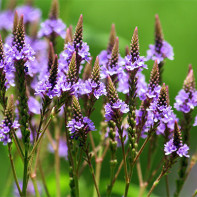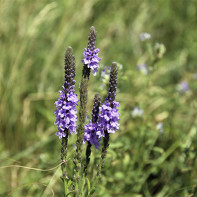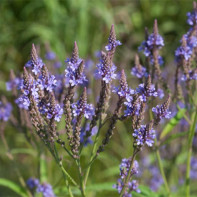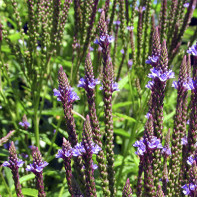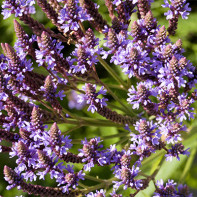Verbena: medicinal properties and contraindications
Verbena is an herbaceous plant, to which people have come up with several other interesting names - such as pigeon grass, cast iron or iron grass. In Latin, it was called "sacred branch," which is much more appropriate for this useful medicinal plant.
- Chemical composition
- How it looks and where it grows
- Types of
- Gathering and storage
- Therapeutic properties of vervain medicinal
- Verbena in folk medicine
- For sore throat and stomatitis
- For colds
- Drops for colds
- Compresses
- Inflammatory lotions
- For Atherosclerosis and Thrombosis
- From Rheumatism.
- Healing compositions
- Infusion
- Tincture
- Decoction
- Tea
- Verbena oil: properties and uses
- Cosmetic applications
- Scrubbing
- Anti-dandruff mask
- For hair rinsing
- Oil Rinse
- Hair mask
- For Body Care
- Healing Bath
- Anti-Aging Application
- Body Lotion
- Toning Ice
- Massage Oil
- Goosefoot Oil
- Contraindications for use
Chemical Composition
Verbena is rich in various substances.
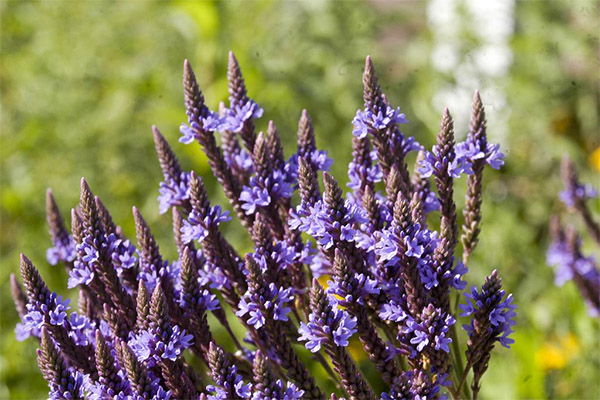
- Among its components is verbenamine, which has a whole complex of useful properties: it relieves inflammation and fever, stimulates the formation of bile, counteracts allergies, removes cramps.
- Glycosides, which are part of the medicinal plant, can fight germs, and also have a soothing, diuretic and vasodilator effect. The tannins in verbena also have the ability to resist germs and bacteria.
- Carotene, which breaks down in the human body and forms vitamin A, contributes to the normal course of oxidative processes, affects metabolism and aging, supports the immune system.
- The essential oil in verbena - an excellent anti-inflammatory and bactericidal, thanks to which the medicinal plant is a sedative. The silicic acid contained in vervain is also an antiseptic.
- Vervain is a treasure trove of vitamin C, which has strong antioxidant properties and is a good wound healer.
- The ability to protect blood vessels from cholesterol buildup and plaque formation gives the medicinal plant the steroid sitosterol. Flavonoids work in tandem with sitosterol, which increases the elasticity of vascular walls and prevents them from being affected by sclerosis.
- The bitterness in the herb has useful properties - it normalizes the work of the digestive system. Such a component of verbena as mucus also affects digestion, having an enveloping effect. Another function of it is expectorant.
What it looks like and where it grows
Verbena can be either an annual or a perennial. This herbaceous or semi-shrubby plant grows up to a meter in height, so it has a very powerful root.
The stem depending on the variety of verbena and growing conditions can look as straight as well as prostrate or even stalked. The shape of the stem is tetrahedral, covered with bristly fuzz. The leaves sit in pairs opposite each other, they are pubescent, oval, with fairly large denticles along the edge. The color is thick green.
Verbena blooms in June or July, depending on the species and the area in which it grows. The small flowers, whose calyxes resemble funnels of five petals up to 2.5 cm in diameter, are assembled in panicle-like inflorescences. Each panicle contains 30 to 50 flowers. Verbena panicles are very colorful; they can be white or yellow, pink or salmon-colored, blue or blue as well as various shades of red. After flowering, in August, light brown or brownish-greenish four-part fruit-nuts are produced.
Verbena likes sunlight, heat and fertile loose soil, drought and light frost tolerates firmly.
Homeland verbena is Europe. But by importation it spread to Asia, Africa, America. In Russia verbena can be found in the Caucasus, European regions and the Urals. Large thickets of this plant does not create, although it grows on forest edges and meadows, on vacant lots and cultural fields, along roads and fences, descends into ravines and rises in the mountains up to 1200 m.
Species
Today botanists have described about two hundred varieties of this plant, but medicine uses only one of them: medicinal verbena. It grows not only in the Northern Hemisphere, but also in Australia and Africa. Their flowers are always purple and can be found not only in the wilderness, but also in urban wastelands and as a weed in the fields.
In most of Russia distributed only 8 of the nearly two hundred species of verbena, and they are all decorative.
- Canadian - this species can bloom until the first of November, so florists love it and actively cultivate it. It reaches only 20 cm in height, flowers - white and pink.
- Rigid - a perennial with lilac flowers. Its peculiarity is the strongly elongated leaves.
- Buenos Airesa - a tall plant, grows up to 120 cm. The flowers have an amethyst color.
- Fragrant, or lemon, is a giant perennial, its height - from 1 m 50 cm to 2 m. This verbena gets its name from the smell of citrus and mint, which can be smelled by rubbing the leaf.
- Large-flowered - this name is given to verbena because of the largest size of flowers, each of them is quite capable of reaching 10 cm. The coloring of flowers is varied, there can be both dark and light.
- Bonnar - the stems reach 1 m in height and are topped with purple umbrella inflorescences. It blooms until late fall.
- Beautiful - this verbena is no more than 30 cm tall and has ball-shaped inflorescences. Flowers are small, but their range of colors is extensive.
- Hybrid - an annual in the form of a compact branched bush. The stems grow no taller than 60 cm. The inflorescence has a shape average between a spike and an umbrella, and the color palette of flowers is rich - from light, white and pink, to purple, and the petals can be both monochrome and with a spot in the middle.
Gathering and storage
For medicinal purposes, verbena is harvested from May to October, but the best time is August, when the plant has already accumulated a sufficient amount of essential oil. All green above-ground parts as well as the root and seeds are suitable for harvesting.
Dry the herb in a draught under a roof so that the sun and rain don't fall on it. You can use an electric dryer, but the temperature regulator in it put on 50 or 60 degrees.
Dried raw materials are stored in a dry room, in boxes, laying the layers between each other with sheets of clean paper. As with all medicinal herbs, the shelf life in this form - 2 years.
Therapeutic properties of verbena
- Verbena remedies are used to treat colds, flu, acute respiratory infections, as well as inflammatory diseases of the throat and respiratory organs - bronchitis, tracheitis, laryngitis, pneumonia.
- The next area of application of the plant is the pathology of the digestive organs and related systems: cholecystitis, chronic hepatitis, cholelithiasis, gastritis (against the background of reduced gastric juice).
- As an external remedy verbena is used to treat compresses and lotions for various types of rashes, furunculosis, skin inflammation, poorly healing wounds. Its decoctions and infusions rinse your mouth for toothache, stomatitis and gingivitis, as well as to get rid of unpleasant odor.
- With skin problems such as psoriasis, eczema, neurodermatitis, compositions of verbena are used both internally and externally.
- The root of the plant is used for parotitis (mumps), children's allergies (scrofula), as well as to save from boils.
- A wide range of tasks solves verbena oil, it is able to put on the feet of the infirm and exhausted, as well as help women in getting rid of many delicate gynecological problems.
- Vervain improves liver function, normalizes digestion and metabolism and raises appetite, supports
health of the heart and blood vessels.
Verbena in folk medicine
As a therapeutic agent, vervain is used by folk healers for a long time. First of all, it is recommended for colds and acute respiratory infections: treat the compositions of a sore throat, runny nose, cough.
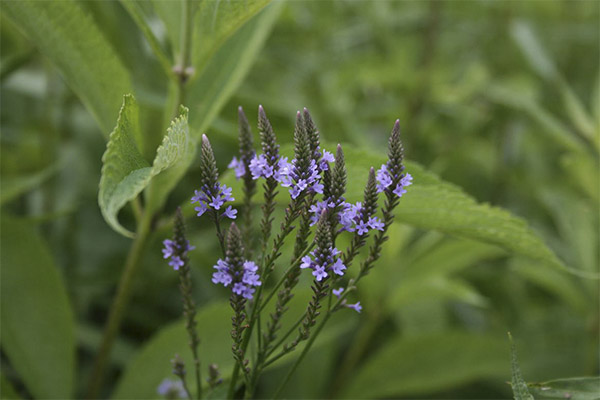
For the treatment of internal pathologies healers also have many recipes with verbena - so, drugs are prescribed for digestive diseases, vascular and cardiac problems, remove inflammation in the mouth, adjust the metabolism, eliminate anemia.
Grind just picked herbs to get rid of bruises, heal skin diseases - rashes, pustules, allergies, wounds that are hard to heal. Since time immemorial, the plant has been used to treat and prevent scurvy, as it contains a large dose of vitamin C.
There are quite exotic methods used by healers since ancient times: verbena pounded and soaked in wine was used to heal people after snake bites. And the juice, mixed with honey and warmed water, used to gargle in the mouth to freshen the breath.
For sore throat and stomatitis
Option 1. Pour a tablespoon of crushed dry raw materials in boiling water (glass). Remove from the fire and leave for an hour to infuse, covered with a lid and a towel for warmth. After straining, it is recommended to rinse the throat for angina or the mouth - for stomatitis or gingivitis. You can make on the basis of the infusion of lotions and apply them to acne, ulcers, manifestations of psoriasis or eczema.
Option 2. Dissolve half a teaspoon of salt in a glass of warm water and drop 15 drops of verbena oil in it. If you are diagnosed with pharyngitis or laryngitis, gargle your throat with this composition. Also indications for use are stomatitis, sore throat, tonsillitis.
For colds
A tablespoon of dry medicinal raw materials pour half a liter of hot water and put on the stove. Boil for 5 minutes on low heat, then remove from the stove and leave until it cools. Strain and pour warm boiled water - so that again it was half a liter. This is the daily rate, you need to drink it during the day in 4 drinks: half a glass before eating. You can drink with honey or raspberry jam.
Nasal drops
If your nose is running, drops made from vervain will be a good help. Mix 2 teaspoons of St. John's wort oil with a drop of verbena oil. Put 2 drops in each nostril three times a day.
Compresses .
Pour 4 tablespoons of dried raw verbena in a small cloth bag and drop it for 30 seconds in boiling water. Remove the bag from the boiling water, cool so you can tolerate, and put on the sore spot. Make such a compress twice a day and keep it for an hour. Indications are skin inflammations, rashes, acne, psoriasis, thrombophlebitis, ulcers and rheumatism.
Inflammatory lotions
To prepare a composition for lotions, use several kinds of herbs: verbena, oak bark, horsetail, rose petals - 10 g each, chamomile and sage leaves - 5 g. Mix the herbs in a dry bowl, take 2 tablespoons of the resulting collection and pour half a liter of just boiling water. Under a tight lid, insist at least 3 hours, then strain and soaking the infusion gauze or cotton cloth, put on the sore spot. Thus, you can accelerate healing of wounds and treat inflammation of the skin.
For atherosclerosis and thrombosis
To clean the blood vessels and reduce the health and life risks of thrombosis or atherosclerosis, you need to scald 2 teaspoons of dried verbena with a glass of boiling water. Insist for an hour, then strain and take a tablespoon of the healing composition every 50-60 minutes.
If you drink this composition by the glass 2 times a day, it will save from a raging migraine and normalize the menstrual cycle. And to relieve fatigue and get the nerves in order, the infusion should be consumed by 100 ml in the morning, at lunchtime and in the evening.
From rheumatism
Pour into a thermos 3 tablespoons of crushed verbena, pour there the same half a liter of boiling water. Cover firmly and infuse for 3 hours, after which strain and use as an anti-rheumatic agent: put on sore spots cloth soaked in a warm composition. If you dilute the infusion in half with boiled water, you can additionally take it inside.
Effective this composition and in case of muscle strain, bruises, neurodermatitis.
Types of medicinal compositions
Verbena is good so that on its basis you can prepare healing compositions in different dosage forms, and the means, prepared according to one recipe, can treat diseases of different systems and organs. And for many pathologies you can prepare several different medicinal compositions.

Infusion
Infusion - the easiest and non laborious way to prepare a healing composition. You just need to scald with boiling water dried and ground verbena grass. A glass of liquid to take 2 tablespoons of raw materials. Insist the composition for 2-3 hours. This remedy is good for restoring disturbed sleep and soothing the nervous system, as well as for colds and as a restorative medicine.
It is important not to exceed the established daily rate - a glass. Divide this volume into as many intakes.
Tincture
Tincture of verbena is used as a tonic, diaphoretic and antipyretic during a cold. Also after its reception begins to secrete gastric juice more actively, the work of the liver comes to normal. In addition, the tincture is able to relieve inflammation and calm the nerves.
To prepare the tincture, you will need a bottle of dark glass. Pour into it 50 g of dried medicinal plant and 700 ml of quality vodka. Cork and put for 3 weeks in an inaccessible place in the sun (but not in the refrigerator). From time to time the bottle should be shaken.
When the tincture is ready, strain it and take a little by teaspoons: a spoon before breakfast, lunch and dinner.
The tincture can be stored both at room temperature and in the refrigerator.
Decoction .
Folk healers prescribe this decoction to patients with liver problems. In addition, such a composition is good for cleaning blood vessels, it is useful for those who have elevated cholesterol, as it promotes the dissolution of cholesterol plaques, which, in turn, is the prevention of thrombosis.
To prepare the decoction, you will need the flowers and leaves of verbena, it is better if they are fresh, not dried. Grind the medicinal plant in such an amount that you get 2 teaspoons of raw materials. Pour them with clean, filtered water (not more than half a liter). Put the composition on low heat and bring to a boil. As it boils - take it off the stove and let it cool. Strain and consume the next day. Drink for a day not more than 200 ml, dividing them into several doses, and evenly distribute throughout the day. Take before meals.
Tea
Verbena tea is good for colds, flu or acute respiratory infections. It will help relieve a fever, take care of a cough. Another use is for menstrual pain, liver discomfort, or kidney cramps.
Tea also calms the nerves, relieves overexcitement, and restores sleep. With systematic tea drinking verbena will improve the condition of the body as a whole, especially affects the bloodstream: the heart and blood vessels will work more clearly, it will be easier for legs suffering from varicose veins and thrombophlebitis.
For tea you need verbena flowers, dried or fresh - there is no difference, both will do. To make a cup of tea, you need to take 1.5 tablespoons of the healing plant.
Brew as usual tea: pour boiling water and leave for 10-15 minutes. Drink twice a day. Sugar and milk are not added.
Verbena oil: properties and uses
The oil is extracted from verbena by steam distillation (or extraction). The raw material for its production are all parts of the plant that grows above the ground - grass, flowers and leaves. The oil is a fluid product with a pleasant light refreshing fragrance, which distinguishes the scent of citrus and light floral notes.
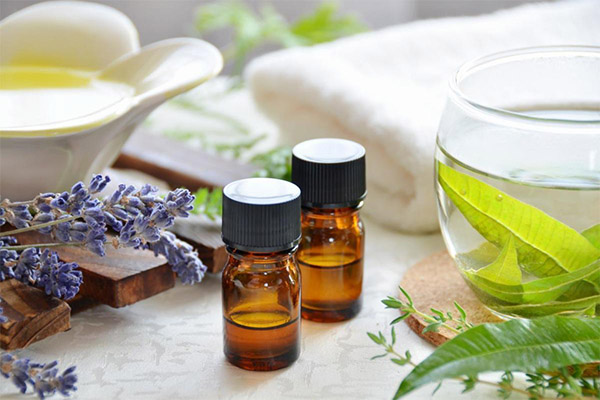
The complex chemical composition of verbena essential oil makes it a truly unique medicinal product. Its components play an important role:
- Terpenes, necessary for humans to normalize the nervous system, vision and reproductive organs.
- The multicomponent substance citral, which has antiseptic, anti-inflammatory and analgesic effects.
- The citrus aroma of limonene that gives the oil its anti-inflammatory and antioxidant effects.
- As well as micro- and macronutrients and a whole complex of vitamins - C, carotene, PP and group B), which give the oil immunomodulatory, sedative, relaxing, antispasmodic properties.
Verbena essential oil has been used by women for a long time. They learned to use it in order to be beautiful, and applied externally as a cosmetic for the face, body, nails, eyebrows, eyelashes and hair.
With its help, they normalized the menstrual cycle, reduced the negative manifestations of menopause, eliminated disorders of the hormonal system as a whole.
It has been found that the pleasant aroma of the essential oil can relieve pain during childbirth, and inhalations, baths or massage with the healing product stimulate milk formation in breastfeeding women.
Due to its antiseptic and expectorant abilities, the oil is suitable for treating diseases of the respiratory system and nasopharynx - such as bronchitis, laryngitis, rhinitis, sinusitis, bronchial asthma. The product also copes with the strengthening of the body's immune system. For gargling, dissolve half a teaspoon of salt in 150 ml of warm water and add 2 drops of oil to the solution. Gargle your throat once every 4 hours.
Due to the sedative and relaxing action of the oil, you can cope with stress and psychological "burnout" syndrome, improve sleep, relieve depression, anxiety and panic attacks.
The product improves blood circulation in the brain, eliminates spasms, normalizes blood pressure, has a positive effect on the cardiovascular system, eliminating vascular dystonia and supports heart function. For a relaxing and restorative bath, add verbena oil to the bath foam: 5 drops per 20 ml of foam. You can replace the foam with 0.5 cup of bath salt. Enjoy the procedure for at least a quarter of an hour. Some people use an aroma lamp or an aromatherapy lamp for the same purpose. It is better to use such methods in the evening - before going to bed.
The digestive system is adjusted with verbena aroma oil, because it cleanses the intestines and "spurs" their peristalsis, as well as relieves nausea.
Since verbena oil is generally recognized as a powerful spasmolytic, as well as a regenerating and wound healing agent, it is used by athletes when they need to prepare for the work of strained muscles. This is where the oil's ability to warm up and stimulate tissues also comes into play. For the same reason it is used to treat bruises, bruises and sprains. Massage is recommended for the muscles. The remedy for the procedure is prepared as follows: take any favorite oil (you can also use the one that is added to salads - olive, sesame, pumpkin, corn) and add verbena aroma oil to it. For every 20 ml of base oil, drop 7-10 drops of verbena oil.
In this way, you must know that verbena oil is a strong aphrodisiac, and it is said that a few drops of it are enough to arouse sensuality and desire.
Cosmetic Uses
As a cosmetic agent, verbena began to be used since ancient Egyptian times. Even then, women noticed its beneficial effects on the skin and the ability to slow aging. Even to this day, the useful properties of the plant are most in demand in anti-aging cosmetics.
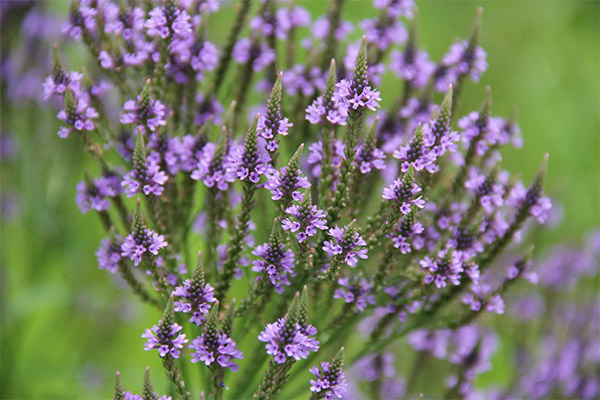
Vervain is able to remove swelling, tighten the facial oval, reduce wrinkles, make the skin more elastic and firm, reducing its flabbiness, and improve complexion. Thanks to its anti-inflammatory properties, it is excellent against pustular rashes, boils, acne, eczema and smoothes the remaining skin irregularities.
In home cosmetology, decoctions, infusions and oil are used. For procedures use not only compositions of verbena in pure form, but also combine them with funds from other plants.
Apply verbena not only for the skin of the face, it can be used as a means to correct the figure. As a result of systematic rubbing of medicines in problem areas improves skin elasticity, it smoothens and rejuvenates, reduces the appearance of cellulite, reduces sweating.
Verbena is also recognized benefits for hair. Since it has the ability to accelerate blood flow, it successfully copes with strengthening hair follicles and improving the condition of the hair itself. Curls get a healthier look, their growth improves. Verbena is good for oily hair, normalizes the sebum formation, removes dandruff.
Fragrance combing
To saturate the hair with curative substances, it is useful to comb them using verbena oil. You will need a wooden comb with sparse teeth. It is necessary to drop a couple of drops of oil on it and gently comb through the strands for 5 minutes.
It is better to perform the procedure in the evening, after a hard day's work. It is useful and pleasant, and quite relaxing.
Anti-Dandruff Mask
Melt a teaspoon of honey in a water bath in an enamel bowl and add three types of oils: a teaspoon of aloe, 4 drops of verbena and 2 tablespoons of castor. Stir until a homogeneous consistency is formed. The resulting product by circular massaging movements rub into the scalp, cover the hair with a shower cap and a towel. After an hour, wash your hair with a shampoo with 2-3 drops of verbena oil.
To be effective, repeat the procedure 4-5 weeks in a row.
To rinse hair
To prepare an effective remedy for rinsing hair, you need to make a decoction of the medicinal plant. Boil for 5 minutes 3 tablespoons of dry verbena in half a liter of water. Leave it for an hour, let it infuse. Strain and add to the decoction a liter of pure water, then rinse your hair with the prepared composition after using shampoo and conditioner.
Rinse with oil.
Take a liter of warm water, drop 5-6 drops of verbena oil in it and immediately rinse your hair until the oil formed balls.
Hair mask
Mix two kinds of oil in a cup: castor oil (2-3 tablespoons) and verbena oil (5-6 drops). Spread on the hair and massage into the scalp. Put on a shower cap and cover your head with a towel for warmth. After an hour, shampoo your hair thoroughly with an ordinary shampoo.
For body care
Squeeze into a cup the amount of body cream that is usually used for a single application. Add 3-4 drops of verbena oil, mix thoroughly and apply to the skin.
Healing Bath
To improve the skin of the body you can massage with a drop of verbena oil, or you can do a bath. It is very simple: just fill up the bathtub with the quantity and temperature that you are accustomed to. Add 7-8 drops of verbena oil to the foam or bath salt and you can enjoy. In addition to beneficial effects on the skin, this procedure will relieve fatigue, calm the nerves, and improve your mood.
Anti-Aging Application
You can use this method for both dry and oily skin, the difference is the base ingredient. For dry skin, take avocado, olive or coconut oil, for oily skin, take grape seed oil. Add 3 drops each of rosemary, geranium and verbena essential oils to 100 ml of the base product and mix. Soak a gauze folded in several layers with the obtained remedy and put it on your face and neck. Lie quietly for half an hour. It is useful to repeat this procedure 2-3 times a week.
Body lotion
This lotion is used only for oily skin. It is necessary to mix in a plastic bottle 3 drops of verbena oil with 200 ml of still mineral water. Rub it on your body daily, shaking the bottle beforehand. With regular use of the lotion the skin will gain elasticity and become more elastic.
Toning Ice
Mix a teaspoon of honey with a drop of verbena oil. Place the mixture in the freezer, and when it turns to ice, you can wipe your face and neck with it. The product perfectly tones, refreshes and tightens the skin. If there is no honey, you can prepare the composition using cream.
Massage oil
A simple massage with verbena oil will improve not only how you feel, but also the condition of your skin. To do this, add verbena oil to the massage oil that you normally use, adding 4-6 drops to 20 grams of the base product.
Oil from "caterpillar feet"
To eliminate small wrinkles, which with age are formed near the corners of the eyes, you can prepare a special oil at home. Take 100 ml of any vegetable or cosmetic oil as a base, add to it 3 drops of three aroma oils - verbena, rosemary and geranium. In the evening, at the end of the day's work, gently beat with your fingertips this aromatic oil cocktail into the skin where the "crows feet" are outlined.
Contraindications for use
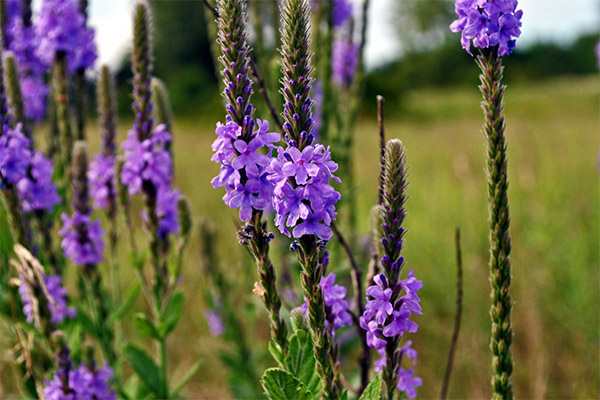
- The means based on verbena are not recommended for women who are carrying a baby, especially in the first trimester, because of the glycosides contained in the plant, it is possible to increase the uterine tone, which is fraught with the abortion of pregnancy.
- Do not treat children under 14 years of age with preparations made from this plant.
- Some physicians have noted the negative effect of verbena on the health of patients suffering from hypertension. This, too, should be taken into account.
- Compositions based on the healing plant are contraindicated for people who have reduced blood platelets.
Before you start treatment with vervain, it is necessary to check the remedy for individual intolerance. It is observed rarely, but it is still better to be insured. If because of a drop of the remedy, applied to the inner surface of the wrist or elbow, redness appeared, healing compositions should not be used.
For the rest of the people, this medicinal plant will not cause any harm, but there are a number of cautions that should be taken into account, so that the treatment does not become a disappointment. First of all, you should remember that you should not take vervain for a long time: there is a risk of irritation of the mucous membranes of the stomach and intestines.
Verbena oil is phototoxic, so it is better to postpone its external use before sunbathing. You should not use it internally on an empty stomach.
Alcohol and verbena - incompatible things, because the healing plant can increase the toxic effect on the liver. Therefore, you should choose one thing: either a shot of hot, or a treatment.
«Important: All information on the site is provided solely for introductory purposes. Before applying these or those recommendations consult with a specialized specialist before applying any of the recommendations. Neither the editors nor the authors shall be liable for any possible harm caused by materials."

